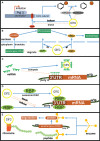Circular RNAs regulate parental gene expression: A new direction for molecular oncology research
- PMID: 36091137
- PMCID: PMC9453195
- DOI: 10.3389/fonc.2022.947775
Circular RNAs regulate parental gene expression: A new direction for molecular oncology research
Abstract
CircRNAs have been the focus of research in recent years. They are differentially expressed in various human tumors and can regulate oncogenes and tumor suppressor genes expression through various mechanisms. The diversity, stability, evolutionary conservatism and cell- or tissue-specific expression patterns of circRNAs also endow them with important regulatory roles in promoting or inhibiting tumor cells malignant biological behaviors progression. More interestingly, emerging studies also found that circRNAs can regulate not only other genes expression, but also their parental gene expression and thus influence tumors development. Apart from some conventional features, circRNAs have a certain specificity in the regulation of parental gene expression, with a higher proportion affecting parental gene transcription and easier translation into protein to regulate parental gene expression. CircRNAs are generally thought to be unable to produce proteins and therefore the protein-coding ability exhibited by circRNAs in regulating parental gene expression is unique and indicates that the regulatory effects of parental gene expression by circRNAs are not only a competitive binding relationship, but also a more complex molecular relationship between circRNAs and parental gene, which deserves further study. This review summarizes the molecular mechanisms of circRNAs regulating parental gene expression and their biological roles in tumorigenesis and development, aiming to provide new ideas for the clinical application of circRNAs in tumor-targeted therapy.
Keywords: circRNAs; molecular oncology; parental gene; regulatory mechanism; tumors.
Copyright © 2022 Wang, Gao, Yu, Wang, Liu, Jiang and Sun.
Conflict of interest statement
The authors declare that the research was conducted in the absence of any commercial or financial relationships that could be construed as a potential conflict of interest.
Figures

Similar articles
-
Circular RNA: an important player with multiple facets to regulate its parental gene expression.Mol Ther Nucleic Acids. 2020 Nov 17;23:369-376. doi: 10.1016/j.omtn.2020.11.008. eCollection 2021 Mar 5. Mol Ther Nucleic Acids. 2020. PMID: 33425494 Free PMC article. Review.
-
Systematic identification and characterization of circular RNAs involved in flag leaf senescence of rice.Planta. 2021 Jan 7;253(2):26. doi: 10.1007/s00425-020-03544-6. Planta. 2021. PMID: 33410920 Free PMC article.
-
The emerging roles and functions of circular RNAs and their generation.J Biomed Sci. 2019 Apr 25;26(1):29. doi: 10.1186/s12929-019-0523-z. J Biomed Sci. 2019. PMID: 31027496 Free PMC article. Review.
-
Circular RNAs (circRNAs) in cancer.Cancer Lett. 2018 Jul 1;425:134-142. doi: 10.1016/j.canlet.2018.03.035. Epub 2018 Apr 3. Cancer Lett. 2018. PMID: 29625140 Review.
-
Progress in research on the role of circular RNAs in lung cancer.World J Surg Oncol. 2018 Nov 6;16(1):215. doi: 10.1186/s12957-018-1515-2. World J Surg Oncol. 2018. PMID: 30400981 Free PMC article. Review.
Cited by
-
CircRNA_012164/MicroRNA-9-5p axis mediates cardiac fibrosis in diabetic cardiomyopathy.PLoS One. 2024 Jul 23;19(7):e0302772. doi: 10.1371/journal.pone.0302772. eCollection 2024. PLoS One. 2024. PMID: 39042659 Free PMC article.
-
Circular RNAs and the regulation of gene expression in diabetic nephropathy (Review).Int J Mol Med. 2024 May;53(5):44. doi: 10.3892/ijmm.2024.5368. Epub 2024 Mar 22. Int J Mol Med. 2024. PMID: 38516776 Free PMC article.
-
Developmental Regulation of circRNAs in Normal and Diseased Mammary Gland: A Focus on circRNA-miRNA Networks.J Mammary Gland Biol Neoplasia. 2025 May 2;30(1):8. doi: 10.1007/s10911-025-09580-w. J Mammary Gland Biol Neoplasia. 2025. PMID: 40314719 Free PMC article. Review.
-
Identification of hsa_circ_0018905 as a New Potential Biomarker for Multiple Sclerosis.Cells. 2024 Oct 9;13(19):1668. doi: 10.3390/cells13191668. Cells. 2024. PMID: 39404430 Free PMC article.
-
Ferroptosis and circular RNAs: new horizons in cancer therapy.EXCLI J. 2024 Apr 25;23:570-599. doi: 10.17179/excli2024-7005. eCollection 2024. EXCLI J. 2024. PMID: 38887390 Free PMC article. Review.
References
-
- Eng C, Holowatyj AN. Colorectal cancer genomics by genetic ancestry. Cancer Discovery (2022) 12(5):1187–8. doi: 10.1158/2159-8290.CD-22-0217 - DOI - PubMed
Publication types
LinkOut - more resources
Full Text Sources

